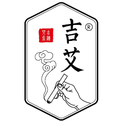The twelve meridians of the human body connect the internal organs and the limbs. Therefore, understanding the characteristics of the symptoms associated with the twelve meridians can help identify the origin of the disease and the nature of the pathological condition.
1. Hand Taiyin Lung Meridian (Shǒu Tàiyīn Fèi Jīng)
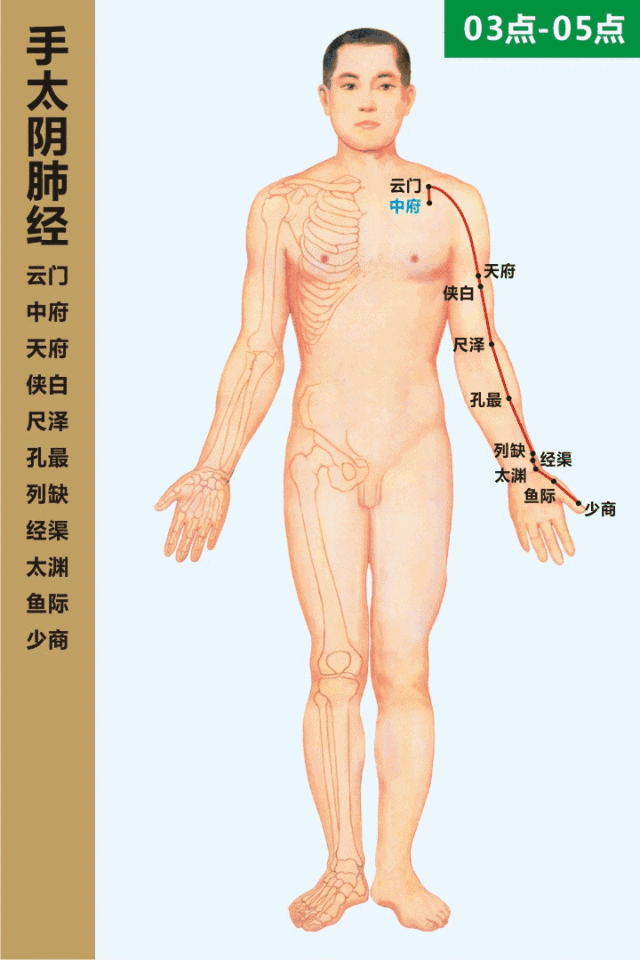
Pathway: Begins at the middle jiao, connects to the large intestine, continues to the stomach, ascends to the diaphragm, belongs to the lung, exits horizontally under the armpit, descends along the inner arm, travels to the heart, descends to the elbow, follows the inner arm to the wrist, enters the palm, follows the thenar, exits at the tip of the thumb. Its branch exits from the back of the wrist, travels along the inner side of the index finger, and exits at its tip.
Main Symptoms: Cough, wheezing, shortness of breath, hemoptysis, common cold, sore throat, spontaneous sweating, and other respiratory system symptoms as well as symptoms along the meridian pathway.
Applications: For sore throat, needle Shaoshang (少商). For vitiligo, moxibustion at Xiahbai (侠白).
2. Hand Yangming Large Intestine Meridian (Shǒu Yángmíng Dàcháng Jīng)
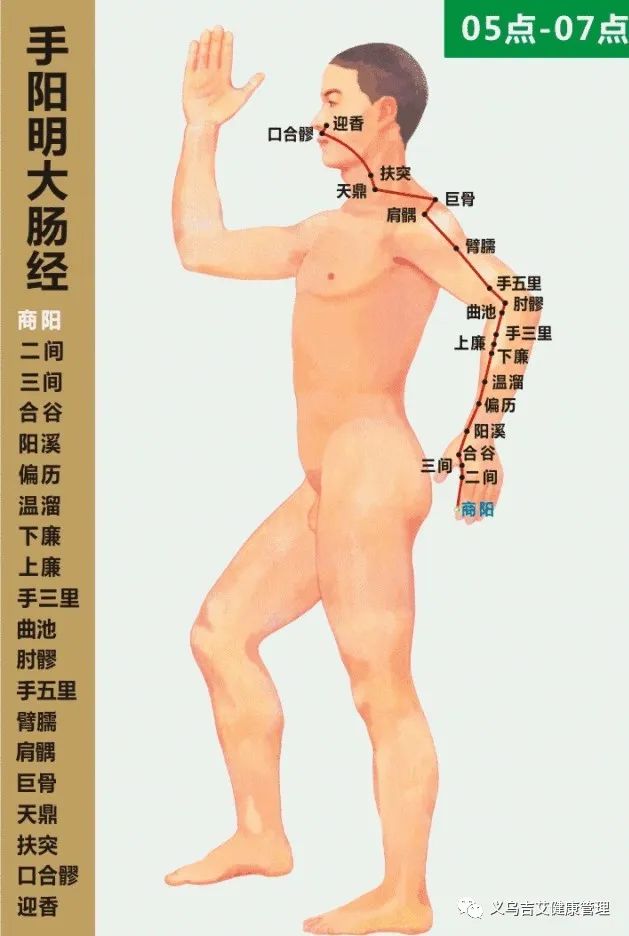
Pathway: Begins at the tip of the thumb and index finger, travels along the outer side of the arm, enters the elbow, ascends along the outer arm, reaches the shoulder, exits in front of the acromion, enters the chest, connects to the lung, descends to the diaphragm, belongs to the large intestine. Its branch ascends from the chest, travels up the neck, enters the lower teeth, exits at the mouth, crosses the philtrum, and ascends to the nostrils.
Main Symptoms: Abdominal pain, borborygmus, diarrhea, constipation, sore throat, toothache, nasal inflammation, nasal congestion, runny nose, diseases of the head, face, and throat, as well as symptoms along the meridian pathway.
Applications: For sore throat, needle Shangyang (商阳) and Shaoshang (少商). For nasal inflammation and congestion, press Yingxiang (迎香) and Hegu (合谷). For lower tooth pain, press Hegu (合谷). For skin diseases, needle Quchi (曲池). For shoulder and arm numbness, needle Jianyu (肩髃) and Binao (臂臑).
3. Foot Yangming Stomach Meridian (Zú Yángmíng Wèi Jīng)
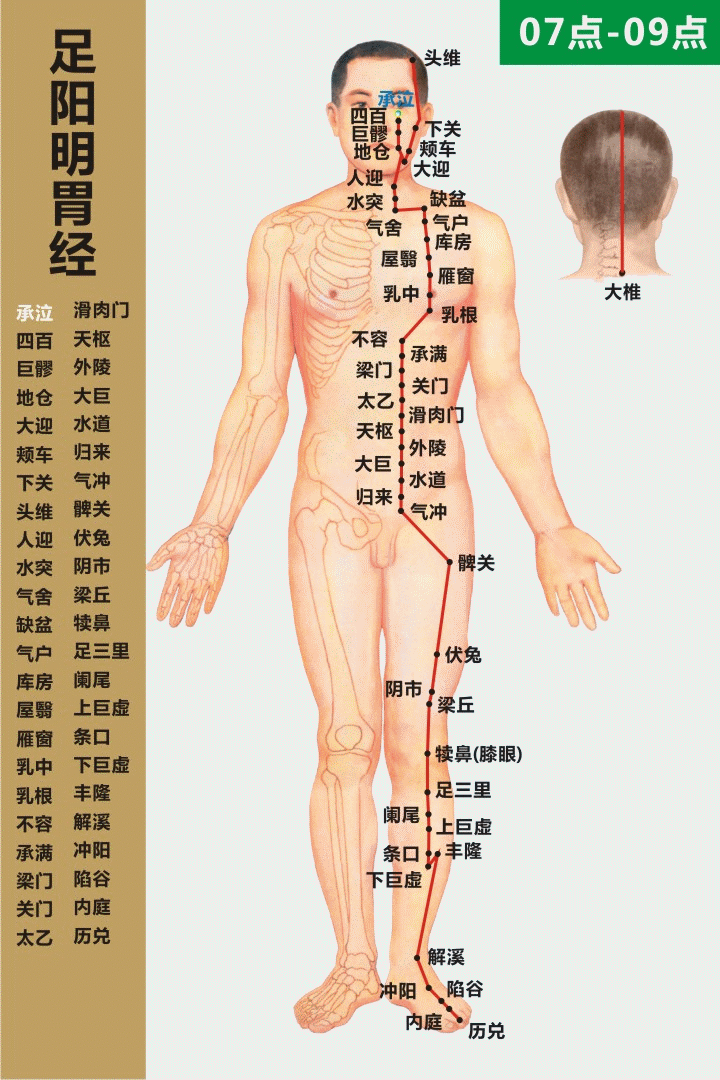
Pathway: Begins at the intersection of the nose, descends along the outer side of the nose, enters the upper teeth, exits at the mouth, descends around the lips, crosses the jaw, ascends in front of the ear, passes through the temporal region, reaches the forehead, and its branch descends from the stomach, travels down the abdomen, enters the lower abdomen, and connects to the bladder. Its direct branch descends from the stomach, travels down the abdomen, and connects to the bladder.
Main Symptoms: Borborygmus, abdominal distension, stomach pain, vomiting, toothache, gastrointestinal diseases, and symptoms along the meridian pathway.
Applications: For hordeolum of the lower eyelid, needle the middle of the second toe. For upper tooth pain, needle Jaw (颊车) and Neiting (内庭). For headache, needle Touwei (头维). For constipation and diarrhea, massage Tianshu (天枢). For all gastrointestinal diseases, moxibustion at Zusanli (足三里). For knee joint diseases, needle Dubi (犊鼻).
4. Foot Taiyin Spleen Meridian (Zú Tàiyīn Pí Jīng)
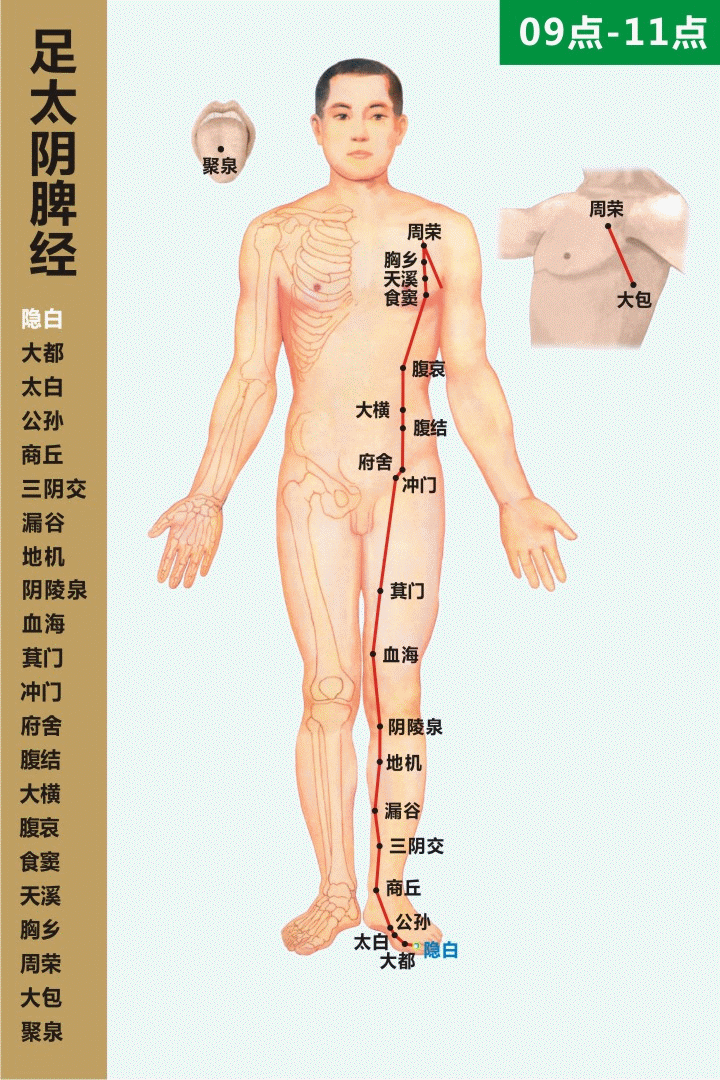
Pathway: Begins at the tip of the big toe, travels along the inner side of the foot, ascends in front of the inner ankle, travels up the tibia, crosses the knee, enters the abdomen, belongs to the spleen, connects to the stomach, ascends to the diaphragm, and connects to the throat, spreading to the tongue. Its branch ascends from the stomach, connects to the heart.
Main Symptoms: Stomach pain, vomiting, abdominal distension, loose stools, spleen and stomach diseases, gynecological diseases, and symptoms along the meridian pathway.
Applications: For metrorrhagia, moxibustion at Yinbai (隐白), Zhongji (中极), and Sanyinjiao (三阴交). For menstrual irregularities, moxibustion at Xuehai (血海), Sanyinjiao (三阴交), and Baliao (八髎). For stubborn constipation in children, massage Dahuang (大横).
5. Hand Shaoyin Heart Meridian (Shǒu Shàoyīn Xīn Jīng)
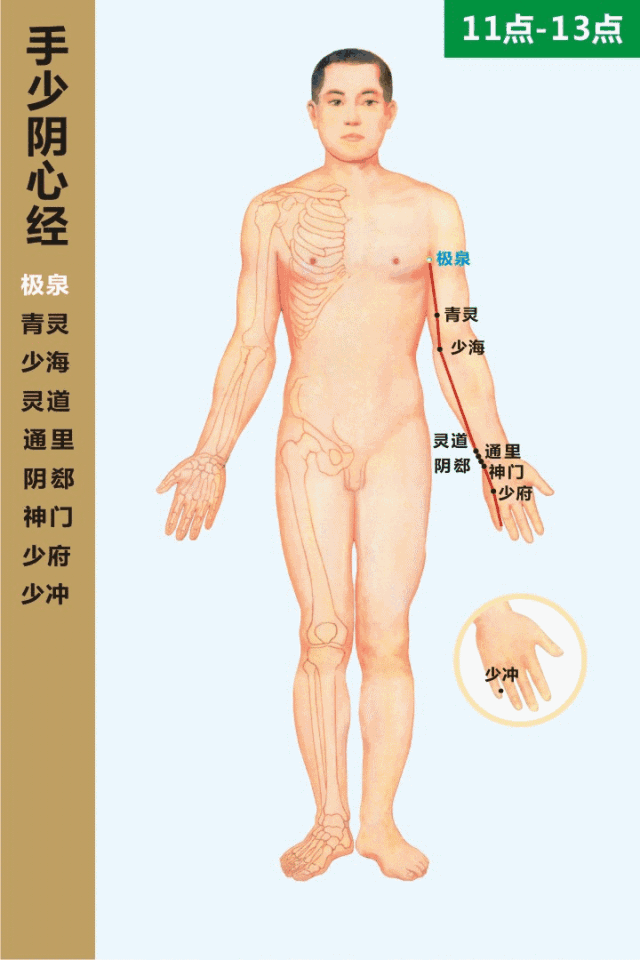
Pathway: Begins at the heart, exits, connects to the diaphragm, and links to the small intestine. Its branch ascends from the heart, travels up the throat, connects to the eyes, and its direct branch ascends from the heart to the lung, descends under the armpit, follows the inner arm, descends to the wrist, enters the palm, follows the little finger, and exits at its tip.
Main Symptoms: Heart pain, dry throat, thirst, chest diseases, and mental disorders.
Applications: For night crying in infants, massage Shenmen (神门).
6. Hand Taiyang Small Intestine Meridian (Shǒu Tàiyáng Xiǎocháng Jīng)
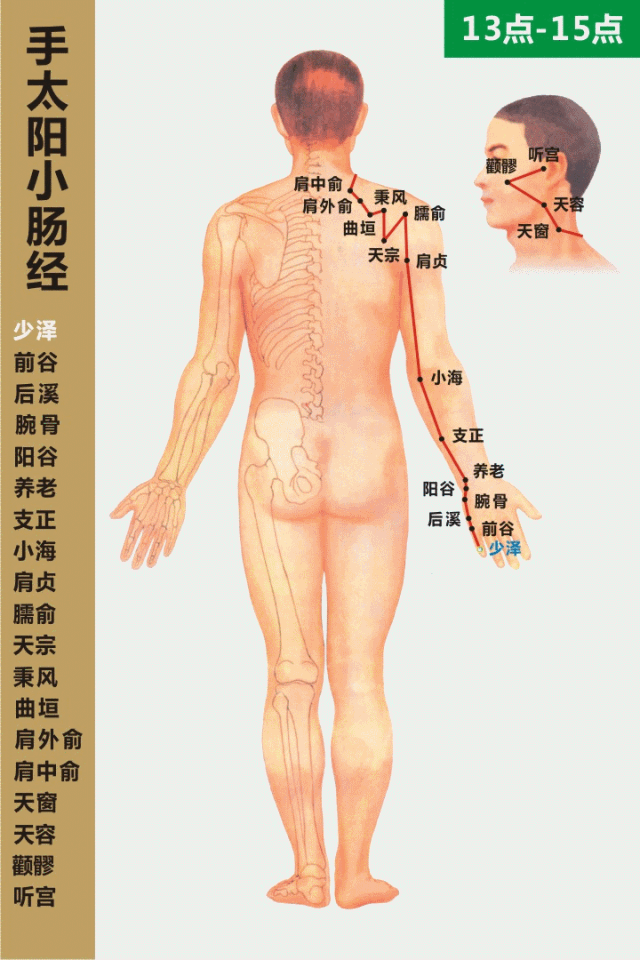
Pathway: Begins at the tip of the little finger, travels along the outer side of the hand, ascends to the wrist, travels up the arm, enters the elbow, ascends along the outer arm, reaches the shoulder, crosses the shoulder blade, enters the chest, connects to the heart, descends to the diaphragm, and connects to the small intestine. Its branch ascends from the chest, travels up the neck, reaches the cheek, enters the eye, and its branch connects to the ear, exiting at the front of the ear.
Main Symptoms: Tinnitus, deafness, red eyes, stiff neck, cervical spondylosis, torticollis, and symptoms along the meridian pathway.
Applications: For eye pain and breast abscess, needle Shaoze (少泽). For stiff neck, massage Houxi (后溪). For hordeolum, moxibustion at Houxi (后溪). For mastitis and shoulder pain, needle Tianzong (天宗).
7. Foot Taiyang Bladder Meridian (Zú Tàiyáng Pángguāng Jīng)

Pathway: Begins at the inner canthus of the eye, ascends to the forehead, crosses the crown, and its direct branch enters the brain, exits at the back of the neck, travels along the shoulder, follows the spine, enters the lower back, connects to the kidney, belongs to the bladder. Its branch descends from the lower back, travels down the spine, enters the knee, and its branch descends from the shoulder, travels down the outer thigh, exits at the outer ankle, and follows the little toe.
Main Symptoms: Nasal congestion, eye diseases, headache, enuresis, and diseases of the head, neck, back, and lower limbs, as well as corresponding organ diseases.
Applications: For myopia, massage Jingming (睛明) and Cuanzhu (攒竹). For cough and nasal inflammation, moxibustion at Fengmen (风门), Feishu (肺腧), and Dazhui (大椎). For digestive disorders and spleen-stomach diseases, moxibustion at Pishu (脾腧). For enuresis, moxibustion at Shenshu (肾腧), Mingmen (命门), and Guanyuan (关元). For low back pain, needle Shenshu (肾腧), Weizhong (委中), Chengshan (承山), and Kunlun (昆仑). For constipation, massage Baliao (八髎) and press Chengshan (承山). For abnormal fetal position, moxibustion at Zhiyin (至阴).
8. Foot Shaoyin Kidney Meridian (Zú Shàoyīn Shèn Jīng)
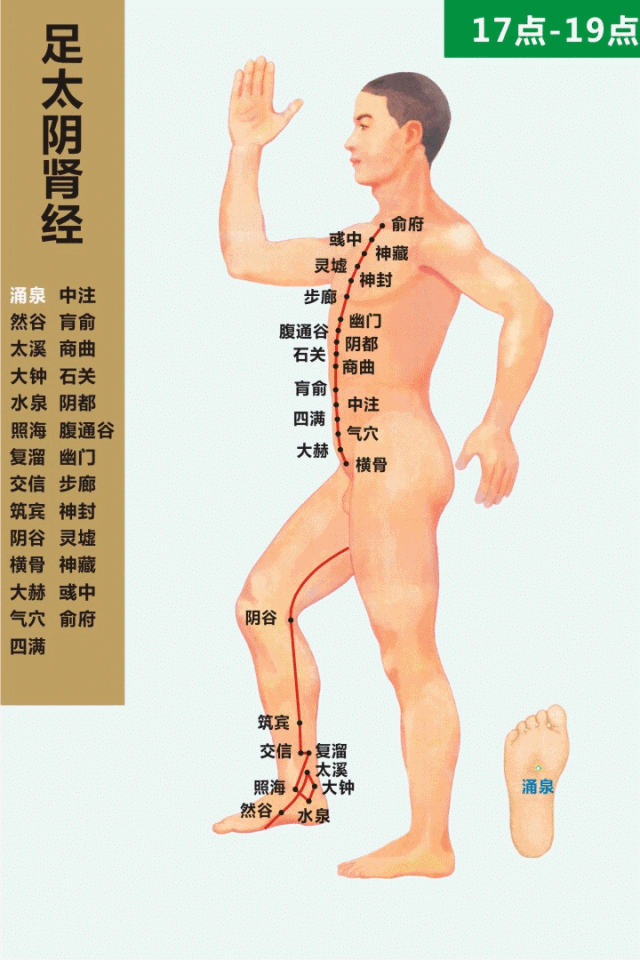
Pathway: Begins at the bottom of the little toe, travels diagonally across the sole, exits below the heel, follows the inner ankle, enters the heel, ascends along the inner thigh, enters the spine, belongs to the kidney, connects to the bladder. Its direct branch ascends from the kidney, enters the liver, connects to the lung, travels up the throat, and follows the base of the tongue. Its branch exits from the lung, connects to the heart, and enters the chest.
Main Symptoms: Asthma, dry tongue, sore throat, constipation, diarrhea, gynecological, genital, kidney, lung, and throat diseases, as well as symptoms along the meridian pathway.
Applications: For phlegm-heat sore throat, moxibustion at Yongquan (涌泉). For chronic pharyngitis, needle Hai (海). For yin deficiency cough, massage Yongquan (涌泉) and Taixi (太溪).
9. Hand Jueyin Pericardium Meridian (Shǒu Juéyīn Xīnbāo Jīng)
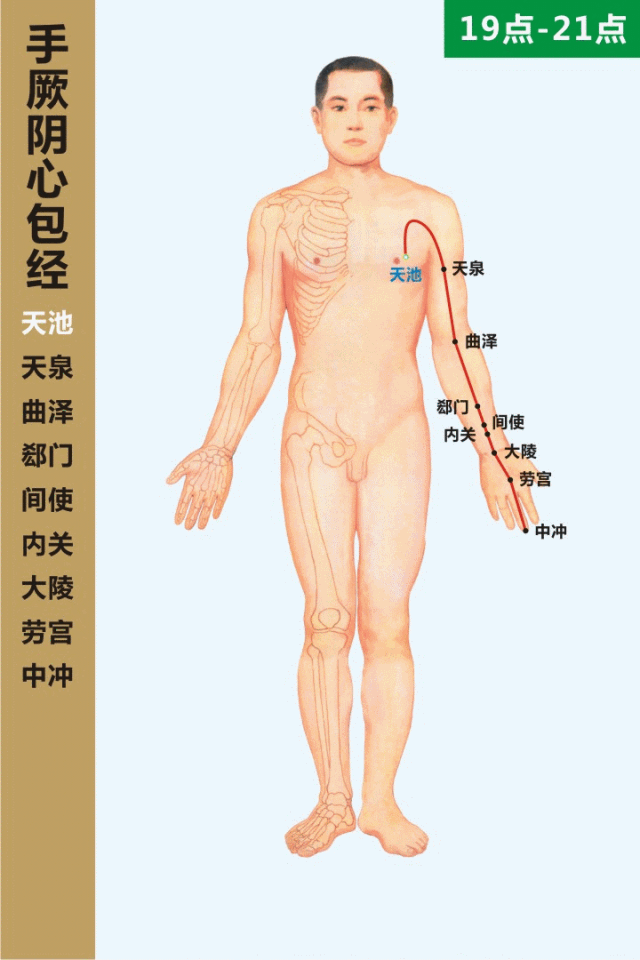
Pathway: Begins at the chest, exits, connects to the pericardium, descends to the diaphragm, and traverses the three jiaos. Its branch travels across the chest, exits at the side, descends three inches below the armpit, ascends to the armpit, follows the inner arm, enters the elbow, descends along the two tendons, enters the palm, follows the middle finger, and exits at its tip. Its branch exits from the palm, travels along the little finger and index finger, and exits at their tips.
Main Symptoms: Night crying, palpitations, irritability, heart pain, and mental disorders, as well as symptoms along the meridian pathway.
Applications: For night crying, needle Zhongchong (中冲). For stomach pain and vomiting, needle or press Neiguan (内关). For motion sickness, press Neiguan (内关).
10. Hand Shaoyang Sanjiao Meridian (Shǒu Shàoyáng Sān Jiāo Jīng)
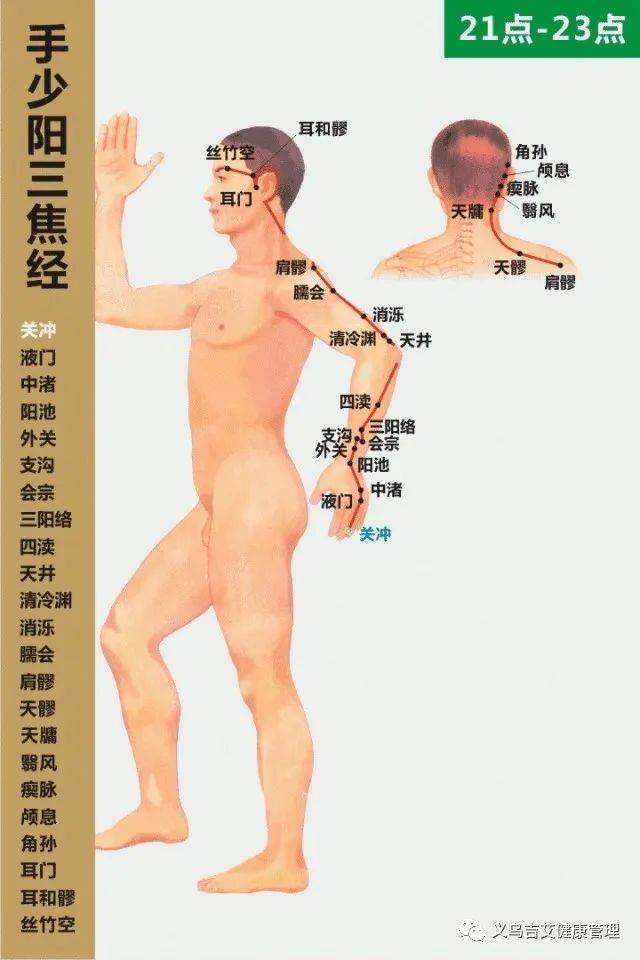
Pathway: Begins at the tip of the index finger, ascends between the two fingers, travels along the outer wrist, exits between the two bones of the arm, ascends through the elbow, follows the outer arm, reaches the shoulder, crosses the shoulder blade, enters the chest, connects to the pericardium, descends to the diaphragm, and connects to the Sanjiao. Its branch ascends from the chest, travels up the neck, reaches the back of the ear, exits at the top of the ear, and descends to the cheek, reaching the eye.
Main Symptoms: Deafness, tinnitus, sore throat, red eyes, and diseases of the ear, eye, and throat, as well as symptoms along the meridian pathway.
Applications: For otitis media and ear pain, needle Zhongzhu (中渚). For tinnitus and deafness, massage Zhongzhu (中渚), Ermen (耳门), Tinggong (听宫), and Tinghui (听会). For headache, massage Wai Guan (外关). For constipation, press Zhigou (支沟). For convulsions in children, moxibustion at Zhi Mai (瘈脉).
11. Foot Shaoyang Gallbladder Meridian (Zú Shàoyáng Dǎn Jīng)
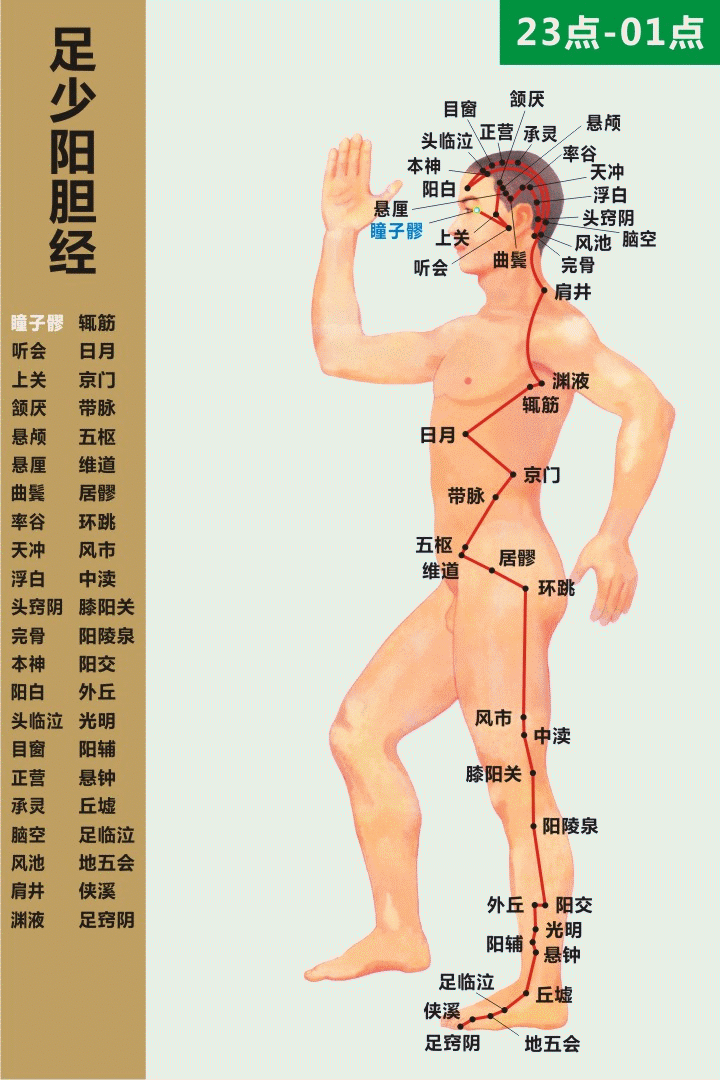
Pathway: Begins at the inner canthus of the eye, ascends to the head, descends behind the ear, travels down the neck along the Shaoyang, reaches the shoulder, crosses the shoulder blade, enters the chest, and connects to the gallbladder. Its branch enters the ear, exits at the front of the ear, and reaches the inner canthus of the eye. Its branch descends from the inner canthus, travels down the jaw, and connects to the chest, traversing the diaphragm, connecting to the liver, belonging to the gallbladder, and travels along the side of the body, exiting at the lower abdomen, and descends along the outer thigh, exiting at the outer ankle, and follows the little toe.
Main Symptoms: Bitter taste in the mouth, dizziness, headache, lateral head pain, and diseases of the eye, ear, and mental disorders, as well as symptoms along the meridian pathway.
Applications: For toothache, needle Shanguan (上关). For lower limb issues, needle Huantiao (环跳). For headache, massage Fengchi (风池).
12. Foot Jueyin Liver Meridian (Zú Juéyīn Gān Jīng)
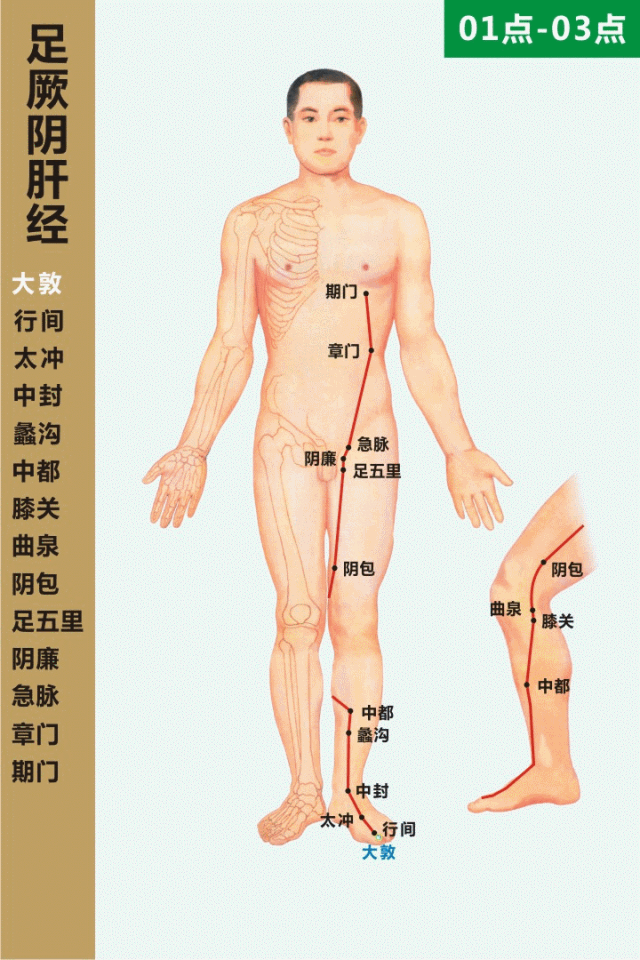
Pathway: Begins at the base of the big toe, ascends along the inner side of the foot, goes one inch above the inner ankle, ascends eight inches, crosses the inner thigh, enters the groin, reaches the lower abdomen, connects to the stomach, belongs to the liver, connects to the gallbladder, ascends through the diaphragm, spreads to the ribs, travels up the throat, and enters the head. Its branch connects to the eyes, ascends to the forehead, and meets the Du Meridian at the crown. Its branch descends from the eye, travels down the cheek, and encircles the lips. Its branch ascends from the liver, connects to the diaphragm, and enters the lung.
Main Symptoms: Chest pain, enuresis, hernia, liver diseases, gynecological diseases, and symptoms along the meridian pathway.
Applications: For hernia, moxibustion at Dazhong (大敦). For night crying, massage Taichong (太冲). For vertex headache, needle Taichong (太冲).

